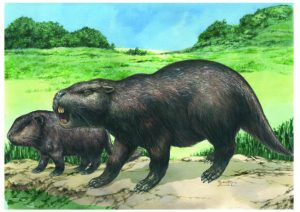
Adult and juvenile remains of a giant rodent species (Isostylomys laurdillardi) have been uncovered by researchers, in the Río de la Plata coastal region of southern Uruguay, raising questions about classification within dinomids.
The study, detailed in Journal of Systematic Palaeontology, consisted of examining teeth structure and development, and comparing the fossils to previously found examples and the largest living rodent — the capybara. It was proposed that, due to similarities in the adult’s and the juvenile’s teeth structure, previously found fossils, which were smaller and thought to belong to a different species, were in fact from the same species.
The authors have consequently proposed that members of the subfamily Gyriabrinae could represent juveniles belonging to other subfamilies of Dinomyidae and that three known species of the genus Isostylomys should be merged into just one species, Isostylomys laurillardi.
Author of the study Andres Rinderknecht commented, “Our study shows how the world’s largest fossil rodents grow and we describe fossil remains of a giant rodent baby and an adult. Comparing them we conclude that from very young the giant rodents already were very similar to the adults which allows us to deduce that the great majority of the hypotheses before posed were wrong. The juvenile and the adult analyzed here represent some of the largest rodents known to science with some of these animals weighing almost a ton.”
The adult remains found consist of an almost complete skull with a partial jaw, while the juvenile’s remains are of a complete lower jaw and right heel. Almost all previous discoveries of this kind have consisted of isolated teeth, and small fragments of skulls or jaws, which make this discovery some of the best-preserved remains of giant dinomids known to date.
Reference:
Andrés Rinderknecht, Enrique Bostelmann, Martín Ubilla. Making a giant rodent: cranial anatomy and ontogenetic development in the genus Isostylomys (Mammalia, Hystricognathi, Dinomyidae). Journal of Systematic Palaeontology, 2017; 1 DOI: 10.1080/14772019.2017.1285360
Note: The above post is reprinted from materials provided by Taylor & Francis Group.










